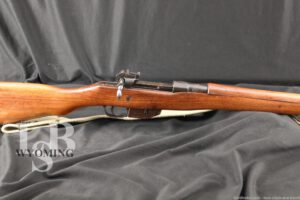
Canadian M-10 Mk. III Ross Bolt Action Rifle In .303 British, 1916 C&R
SOLD FOR: $2,125.00
WOA#: WY240614RF038
Make: Ross Rifle Co., Canada
Model: M-10 Mk. III
Serial Number: NSNV
Year of Manufacture: 1916
Caliber: .303 British
Action Type: Bolt action, 5 round internal magazine
Markings: The top of the receiver is marked, “ROSS RIFLE CO. M-10 PATENTED” The safety is marked, “READY / SAFE”. The bottom metal is marked, “1017”. There are various proofs throughout. The stock is marked, “603 / 1916”
Barrel Length: 30”
Sights / Optics: The front sight is a blade set on a barrel mounted base with a protective hood. The rear sight is a flip up U-notch / aperture with fine adjustment.
Stock Configuration & Condition: The stock is a two piece walnut set with a capped forend/bayonet lug w/ parade sling loop, barrel band w/ sling loop, through bolt, semi-pistol grip, curved comb, and steel buttplate. There are light pressure dents and scratches throughout. There is a crack in the top handguard. The LOP measures 13.25” from the front of the trigger to the back of the buttplate. The stock rates in about Fine overall condition as an antique.
Type of Finish: Blued
Finish Originality: Original
Bore Condition: The bore is bright and the rifling is sharp. There is no erosion in the bore. In this writer’s opinion, this bore rates 9.5/10.
Most antique firearms have bores that will show erosion. This is not only due to age but to the use of black powder. When fired, black powder reacts corrosively. NRA Antique Firearm Conditions Standards are quite lenient for bores. In some cases, the NRA standards disregarded the bore’s condition for collectors’ firearms.
Overall Condition: This rifle retains about 80% of its metal finish. There is thinning and patina throughout. There are scratches, nicks, and impact marks throughout. The action has moderate wear. The screw heads show moderate use. The markings are clear. Overall, this rifle rates in about Fine Plus condition as an antique.
Mechanics: The action functions correctly. We did not fire this rifle. As with all used firearms, a thorough cleaning may be necessary to meet your maintenance requirements.
Box, Paperwork & Accessories: Cotton sling.
Our Assessment: The Canadian M-10 Mk. III Ross Bolt Action Rifle, chambered in .303 British, is a historically significant firearm that played a key role in Canadian military history during the early 20th century. Designed by Sir Charles Ross, a Scottish-Canadian arms manufacturer, the Ross rifle was initially intended to provide Canadian forces with a domestically produced, modern, and accurate military rifle. Despite its promise, the M-10 Mk. III Ross rifle is best remembered for both its precision and the controversy surrounding its performance in combat conditions during World War I. Introduced in 1910, the Mk. III was the final iteration of the Ross rifle, and it was primarily issued to Canadian troops during World War I. The rifle features a straight-pull bolt-action mechanism, which was relatively uncommon compared to the more traditional turn-bolt designs used in most military rifles of the time. The straight-pull action allowed the shooter to cycle the bolt back and forth in a straight line, theoretically providing faster operation and a higher rate of fire. However, while the system was innovative and could perform well in controlled conditions, it proved to be less reliable in the muddy, dirty, and harsh environments of trench warfare. Chambered in .303 British, the standard cartridge of the British Empire, the M-10 Mk. III Ross rifle was designed to fire the same ammunition as the British Lee-Enfield rifle, which was the standard issue rifle of British forces. The .303 British round was well-regarded for its stopping power, range, and general effectiveness on the battlefield. The Mk. III’s long barrel, typically around 30.5 inches, allowed for good accuracy at extended ranges, and the rifle was initially praised for its precision shooting, making it popular among marksmen and snipers. Despite its potential for accuracy, the Ross rifle faced significant problems in the field. One of the main issues was the rifle’s tendency to jam when exposed to dirt, mud, and other debris commonly encountered in trench warfare. The tight tolerances of the straight-pull action, while beneficial for accuracy, made the rifle highly susceptible to fouling. Soldiers in the trenches often found that the rifle would malfunction when it became dirty, which was a frequent occurrence in the muddy battlefields of World War I. This led to reliability issues, and many Canadian soldiers began to distrust the weapon during combat. Another major flaw was the bolt design, which could be reassembled incorrectly after field-stripping. If the bolt was not put back together properly, it could be fired without locking securely, posing a significant safety risk to the shooter. There were several reported incidents where the bolt would blow back into the soldier’s face, causing severe injuries. This safety issue, combined with the rifle’s tendency to jam, led to widespread dissatisfaction among Canadian troops. Despite these problems, the Mk. III Ross rifle continued to be used during the early years of World War I, largely due to logistical constraints and the need to equip a rapidly expanding army. However, as the war progressed, many Canadian soldiers abandoned their Ross rifles in favor of the more reliable British Lee-Enfield rifles, which they picked up from fallen comrades or traded for whenever possible. By 1916, the Ross rifle was largely phased out from front-line service, and Canadian troops were officially rearmed with the Lee-Enfield.
Overall, the Canadian M-10 Mk. III Ross Bolt Action Rifle in .303 British is a rifle that embodies both innovation and controversy. While it was highly accurate and had potential as a precision firearm, its unreliable performance in the trenches and safety issues ultimately led to its downfall as a military rifle. Despite this, it remains an important part of Canadian military history and a valuable collectible for firearms enthusiasts and historians today. -R.E.

